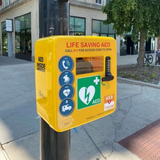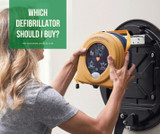What is CPR?
Knowing the basics of first aid and how to deliver CPR (cardiopulmonary resuscitation) can make the difference between life and death. If someone suddenly falls ill, delivering correct CPR can really make all the difference. This blog aims to showcase how to perform CPR and to raise the awareness of its importance so that more members of the public know what to do in an emergency.
About CPR
Oxygen is what keeps us alive, without it our bodies would start to shut down as vital organs cannot survive very long without a constant oxygen supply. With this, oxygen is circulated around our body every second when we breathe in and out. When we breathe in, oxygen enters the bloodstream then, blood is pumped around our bodies by our heart. If a heart stops beating however, this is when the body experiences a lack of oxygen as blood is no longer being pumped to the bodies vital organs - thankfully, CPR can help to solve this.
Working as an emergency procedure in order to restore the flow of blood and oxygen around the body, CPR combines chest compressions and rescue breaths in order to manually provide oxygenated blood where it is needed. CPR basically temporarily takes over the role of the person who has fallen ill and works as their heart and lungs.
Chest Compressions and Rescue Breaths
For CPR to be delivered adequately, chest compressions and rescue breaths must be of course given correctly. To do this, chest compressions involve placing one hand on top of the other and interlocking fingers, the heel of the hand is then pressed on the sufferer’s chest. Using straight arms, the bottom of the hand should be pushed down on the breastbone and released. It is important to remember that these compressions must be relatively hard in order to help restart the heart. These compressions should be roughly five to six centimetres in depth and at a rate of 100 to 120 a minute.
As well as compressions, rescue breaths are also required in order to perform adequate CPR. Rescue breaths are to be given by tilting back the head and lifting the chin in order to clear the airway then pinching the sufferer’s nose. Using a normal breath, the person delivering CPR must create a seal by placing their mouth over the victim’s and breath out for no longer than five seconds and repeat for another breath.
The Steps of CPR
Recommended by the British Heart Foundation, if someone who is suffering and you believe may need CPR, you should:
Step 1: Shake and shout
Step 2: Check them for normal breathing
Step 3: Call 999
Step 4: Give 30 chest compressions
Step 5: Give two rescue breaths
Step 6: Repeat steps 1 to 5 until an ambulance arrives
The British Heart Foundation has very useful tips on what to do if someone suffers a SCA or needs CPR. You can visit their website here:
https://www.bhf.org.uk/?gclid=EAIaIQobChMIhPavvorw...
CPR Training
CPR manikins are a great way to train people on how to deliver the best CPR. Used in health and safety courses up and down the country, CPR manikins work as a realistic model for novices to practice on. Being life like in size and appearance, they really help the learner understand what it would be like to give CPR to a real victim. Manikins not only help in training but in turn by also helping to increase survival rates - the more people that are trained to deliver CPR, the more lives saved.
The Role of Defibrillators
Defibrillators are great medical tools that help save lives when someone suffers a SCA. Working by shocking the heart back to it’s natural rhythm if a shock is needed, defibrillators can increase survival rates ten fold. If you see someone who is suffering a SCA, always start CPR but also use a defibrillator if one is available. They are designed for use by anyone thanks to their simple design and help a huge amount when it comes to saving someone’s life.
Recent Posts
-
Empowering Communities: The Lifesaving Impact of CPR on Restart a Heart Day
Every year, on and around October 16th, an important event takes place - Restart a Heart Day. This a …16th Oct 2023 -
Which home defibrillator?
80% of all out of hospital cardiac arrests occur at home. Defibrillators are often available in loca …4th Dec 2022 -
Which defibrillator should I buy?
There are many defibrillators available on the market and it can become overwhelming knowing which o …4th Nov 2022




